Starter (For Sedan Except Cold Area Specification Vehicles) -- Inspection |
| 1. INSPECT STARTER ASSEMBLY |
- NOTICE:
- Perform each of the following tests within 3 to 5 seconds.
Perform pull-in test.
Disconnect the field coil lead wire from terminal C.
Connect the battery to the starter magnetic switch as shown in the illustration and check that the pinion gear is extended.

Perform holding test.
Check that the pinion gear does not return inward after the cable of terminal C is disconnected.
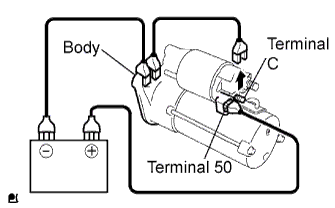 |
Inspect the clutch pinion gear return.
Disconnect the negative (-) lead from the starter body and move the pinion gear toward the armature.
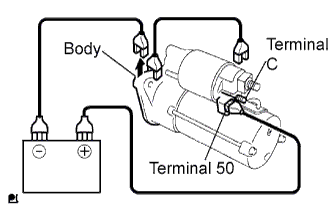 |
Perform the operation test without load.
Connect the field coil lead wire to terminal C.
- Torque:
- 9.8 N*m{100 kgf*cm, 87 in.*lbf}
Clamp the starter in a vise.
Connect the battery and ammeter to the starter as shown in the illustration.
Check that the ammeter indicates the specified current.
- Standard current:
- 90A or less at 11.5V
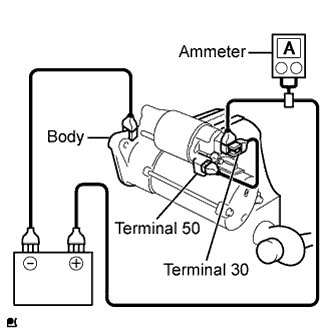
| 2. INSPECT STARTER ARMATURE ASSEMBLY |
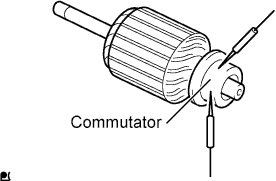 |
Check the commutator for open circuits.
Using an ohmmeter, check the resistance between the segments of the commutator.
- Standard resistance:
- Below 1 Ω
Check the commutator for ground.
Using an ohmmeter, check the resistance between the commutator and the armature core.
- Standard resistance:
- 10 kΩ or higher
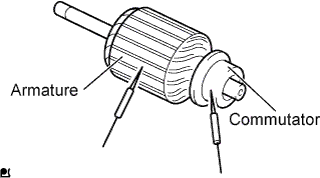 |
Check the commutator surface for dirt and burns.
If the surface is dirty or burnt, restore it with sandpaper (No. 400) or a lathe.
Check for the commutator cirumference runout.
Place the commutator on V-blocks.
Using a dial indicator, measure the cirumference runout.
- Maximum runout:
- 0.05 mm (0.0020 in.)
 |
Using vernier calipers, measure the commutator diameter.
- Standard diameter:
- 28.0 mm (1.1024 in.)
- Minimum diameter:
- 27.0 mm (1.0630 in.)
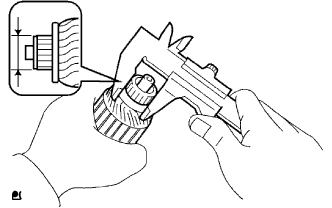 |
Check that the undercut portion between the segments is free of foreign matter and measure its depth.
- Standard undercut depth:
- 0.6 mm (0.0236 in.)
- Minimum undercut depth:
- 0.2 mm (0.0079 in.)
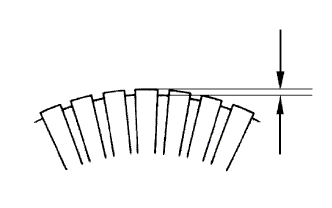 |
| 3. INSPECT STARTER YOKE ASSEMBLY |
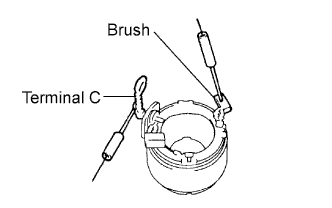 |
Using an ohmmeter, check the resistance between terminal C and the field coil brush lead.
- Standard resistance:
- Below 1 Ω
Using an ohmmeter, check the resistance between the brush lead and the starter yoke.
- Standard resistance:
- 10 kΩ or higher
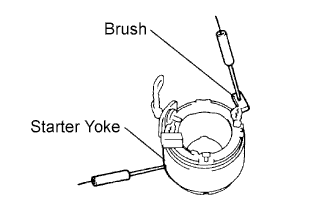 |
| 4. INSPECT BRUSH |
 |
Using vernier calipers, measure the brush length.
- Standard length:
- 14 mm (0.5511 in.)
- Minimum length:
- 9 mm (0.3543 in.)
| 5. INSPECT STARTER BRUSH HOLDER ASSEMBLY |
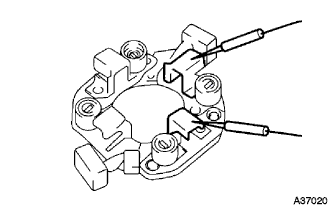 |
Using an ohmmeter, measure the resistance between the positive (+) and negative (-) brush holders.
- Standard resistance:
- 10 kΩ or higher
| 6. INSPECT STARTER CLUTCH SUB-ASSEMBLY |
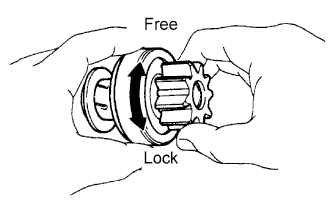 |
Hold the starter clutch and rotate the pinion gear clockwise, and check that it turns freely. Try to rotate the pinion gear counterclockwise and check that it locks.
If necessary, replace the starter clutch sub-assembly.
| 7. INSPECT MAGNET STARTER SWITCH ASSEMBLY |
 |
Check the plunger.
Push in the plunger and check that it returns quickly to its original position.
If necessary, replace the magnet starter switch assembly.
Check the pull-in coil for open circuits.
Using an ohmmeter, check the resistance between terminals 50 and C.
- Standard resistance:
- Below 1 Ω
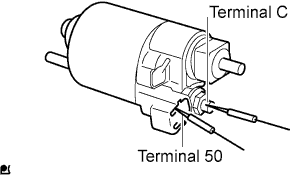 |
Check whether the holding coil has open circuit.
Using an ohmmeter, check the resistance between terminal 50 and the switch body.
- Standard resistance:
- Below 2 Ω
 |